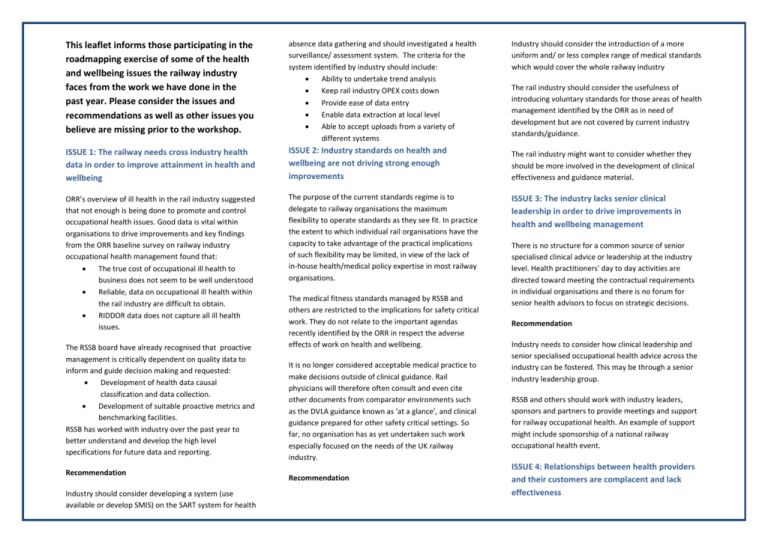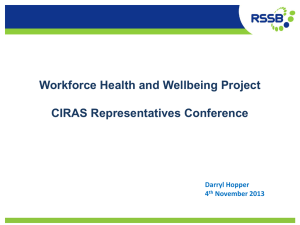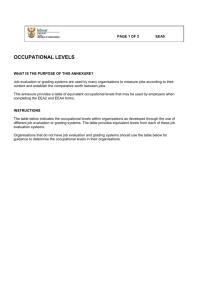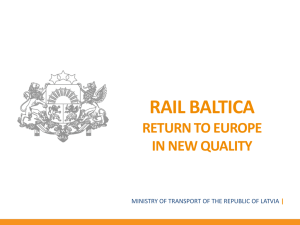Health issues leaflet
advertisement

This leaflet informs those participating in the roadmapping exercise of some of the health and wellbeing issues the railway industry faces from the work we have done in the past year. Please consider the issues and recommendations as well as other issues you believe are missing prior to the workshop. absence data gathering and should investigated a health surveillance/ assessment system. The criteria for the system identified by industry should include: Ability to undertake trend analysis Keep rail industry OPEX costs down Provide ease of data entry Enable data extraction at local level Able to accept uploads from a variety of different systems ISSUE 1: The railway needs cross industry health data in order to improve attainment in health and wellbeing ISSUE 2: Industry standards on health and wellbeing are not driving strong enough improvements ORR’s overview of ill health in the rail industry suggested that not enough is being done to promote and control occupational health issues. Good data is vital within organisations to drive improvements and key findings from the ORR baseline survey on railway industry occupational health management found that: The true cost of occupational ill health to business does not seem to be well understood Reliable, data on occupational ill health within the rail industry are difficult to obtain. RIDDOR data does not capture all ill health issues. The purpose of the current standards regime is to delegate to railway organisations the maximum flexibility to operate standards as they see fit. In practice the extent to which individual rail organisations have the capacity to take advantage of the practical implications of such flexibility may be limited, in view of the lack of in-house health/medical policy expertise in most railway organisations. The RSSB board have already recognised that proactive management is critically dependent on quality data to inform and guide decision making and requested: Development of health data causal classification and data collection. Development of suitable proactive metrics and benchmarking facilities. RSSB has worked with industry over the past year to better understand and develop the high level specifications for future data and reporting. Recommendation Industry should consider developing a system (use available or develop SMIS) on the SART system for health The medical fitness standards managed by RSSB and others are restricted to the implications for safety critical work. They do not relate to the important agendas recently identified by the ORR in respect the adverse effects of work on health and wellbeing. It is no longer considered acceptable medical practice to make decisions outside of clinical guidance. Rail physicians will therefore often consult and even cite other documents from comparator environments such as the DVLA guidance known as 'at a glance', and clinical guidance prepared for other safety critical settings. So far, no organisation has as yet undertaken such work especially focused on the needs of the UK railway industry. Recommendation Industry should consider the introduction of a more uniform and/ or less complex range of medical standards which would cover the whole railway industry The rail industry should consider the usefulness of introducing voluntary standards for those areas of health management identified by the ORR as in need of development but are not covered by current industry standards/guidance. The rail industry might want to consider whether they should be more involved in the development of clinical effectiveness and guidance material. ISSUE 3: The industry lacks senior clinical leadership in order to drive improvements in health and wellbeing management There is no structure for a common source of senior specialised clinical advice or leadership at the industry level. Health practitioners' day to day activities are directed toward meeting the contractual requirements in individual organisations and there is no forum for senior health advisors to focus on strategic decisions. Recommendation Industry needs to consider how clinical leadership and senior specialised occupational health advice across the industry can be fostered. This may be through a senior industry leadership group. RSSB and others should work with industry leaders, sponsors and partners to provide meetings and support for railway occupational health. An example of support might include sponsorship of a national railway occupational health event. ISSUE 4: Relationships between health providers and their customers are complacent and lack effectiveness The broad knowledge and experience of clinicians can respond to the challenges facing the industry to address the adverse effects of work processes and workplace hazards on employees. This may also include the wider determinants of wellbeing as identified by the ORR occupational health programme. However, many tendered outsource contracts are focused on measurable outputs such as KPIs rather than on higher level outcomes. Provision of health from occupational health providers is transactional and costly. Providers and purchasers agree that there is a restricted choice facing rail organisations looking to outsource or re-tender their OH service. The restricted occupational health market prevents the rail industry from gaining access to some of the more innovative approaches and contracts for occupational health management. tend to focus on routine activities, rather on an organisational strategy to improve health. There are two main barriers to creating a wider market in occupational health, these being the need to meet the specific standards of Link-up accreditation and to provide clinic facilities in each and every railway centre. Health and safety managers are well equipped to identify workplace hazards, but when it comes to the risk to health, they need to understand whether there could be any adverse effects on the human body. The level of knowledge required to be able to understand the potential severity of effects on health and the likelihood of an occurrence for a particular individual, may on occasion, stretch beyond the standard training of health and safety managers. Recommendation There appears to be a poor understanding of the role of occupational health amongst frontline managers, and how to get the best value for money from occupational health professionals and providers. Recommendation Commissioners and providers of occupational health need to find ways of enabling their senior clinicians to work more strategically with senior operational, human resource and safety managers in ways which might include: 1. Regular quarterly health strategy meetings including lead physicians, safety and human resource managers. 2. Involvement and inclusion of senior clinicians in one-off programs tackling issues where health may be a concern. Organisations need to consider how to facilitate a broader approach to tendering for their occupational health service, ensuring they have sufficient choice and can take advantage of advances in occupational health practice. Broader approaches might include contracting with more than one organisation to ensure national coverage, or else to gain especial expertise. Opening up the accreditation scheme by integrating Link-up into a railway-specific domain of the Safe Effective Quality Occupational Health Service (SEQOHS) should lead to a significant widening of the occupational health provider market. Further measures to expand this market might include looking to provide clinics facilities available to rent in railway centres by landlords such as Network Rail, as occurs with other railway related services. RSSB and others might consider developing guidance on good commissioning in the industry jointly with occupational health bodies such as the Faculty of Occupational Medicine and/or the Society of Occupational Medicine. ISSUE 6: There is a lack of training and competence within industry to improve health and wellbeing attainment ISSUE 5: The market for occupational health and health and wellbeing provision is stagnant There is a lack of internal knowledge available for determining how to improve health management. Experienced health professionals from external health providers are limited to transactional relationships that Line managers are often expected to manage health risk, but as a rule, they receive little or no training in relation to health management Recommendation A study by RSSB indicates that a return of 10:1 can be achieved through better management of occupational health issues. A good return is therefore available for those that increase the number of OH professionals. Organisations need to improve the standard of health knowledge and training of those with health responsibilities. NEBOSH offer existing packages for frontline managers and health and safety managers. Additional guidance material could also be developed through RSSB. Many rail organisations would benefit from increased support from health specialists. For example, when health risks such as those associated with silica dust, diesel engine exhaust emissions and cab design are considered, consultation with occupational hygienists and ergonomists could add significant value. ISSUE 7: Rail companies do not appear to have complete control over the health hazards facing them Between 2005 and 2010, only seven cases of prescribed occupational disease were reported to ORR; these included four cases of HAVS plus one case each of bursitis, Legionnaires ’ disease, and dermatitis. Underreporting of prescribed diseases may, in part, be attributable to long latency in health problems and the need for a medical diagnosis of an occupational causation, coupled with significant movement of the workforce between employers. There is some evidence to suggest under-reporting of Schedule 3 diseases under RIDDOR. In 2002, as a result of a targeted health surveillance exercise at a single train depot, 24 cases of HAVS were diagnosed and reported under RIDDOR, showing the value of effective health surveillance. RSSB Identified the Top 5 health issues to the rail industry related to health risk. 1. Anxiety, depression, stress 2. Musculoskeletal Disorders, eg back pain 3. Endocrine Disorders, eg diabetes, 4. Heart/Circulatory Conditions eg heart disease, high blood pressure 5. Sleep Disorders, eg sleep apnoea, shift pattern related sleep disorder The CiPD identifies stress as one of the leading causes of absenteeism and is a health hazard with little control. Recommendation The formation of health hazard such as the Ballast Dust Working Group. A project that systematically identifies typical rail environments and the health risks associated. Completion of risk assessments and guidance standards for each environment. Improvements in health data collection and the management of health surveillance. Issue 8: The rail industry works with a supplier base that is largely overlooked in its contribution to the railway system. Health management practices are often poorly integrated within the management practices of these organisations From anecdotal discussions with rail professionals it has been identified that improvements should be made to: Management of health into equipment that enters into the rail system Innovation of new equipment that can improve health Management of people working for contractors lower down in the rail system. Transient employees, health conditions and risks passed on to those lower down the supply chain. ISSUE 9: To meet future business requirements the rail industry needs to improve the management of its workforce. Health and wellbeing makes this management sustainable and effective, however, this is largely overlooked The rail technical strategy (RTS) notes that ‘people are the key drivers and enablers in business’. As the pace of technological change increases people will need the necessary skills to cope and to understand and adapt to new practices. In relation to the goals of the RTS there is a need for: Job design and the professionalization of the workforce Job design and training to fit longer working lifetimes Psychological wellbeing and sustainable engagement for committed people Health management and engagement to create a culture of continuous improvement and an ethos of customer service Resilience, flexibility and communication skills to become highly competent but prevent individual burnout. Design of technology and roles with people in mind The RTS also notes that innovation can alter the workplace as automation could take over repetitive and arduous tasks. The railway has an opportunity to use these techniques and technologies to create an attractive work environment that makes it the employment sector of choice. Issue 10: If the aims of the future railway are to be met the industry needs to be an attractive prospect for government funding and skilled employees. The industry is yet to earn a reputation as an attractive prospect. For Whole-system costs, revenues and subsidy the benchmarking carried out in the VfM shows that total system costs in GB rail are higher than in the comparator European railways. These higher costs are borne by a mixture of higher taxpayer subsidy and higher fares. It is therefore said that the rail industry must earn its right to grow and be sustainable. Whole system costs should be important to all railway organisations and whole systems costs due to ill health are said to be significant. It is estimated that workforce ill health costs the industry 3.5 million working hours per annum. Independent RSSB research suggests that the total cost associated with an identified ‘top five’ occupational health risks is approximately £220 million per year. This potential cost was recognised in the Rail VfM study report which identified the need to ‘increase the focus on occupational health, which will reduce levels of sickness and absenteeism as well as encouraging a healthier workforce’. The RTS identified a pathway for GB railway to become a significant global player in its field. The People section of the strategy, one of its foundation sections, currently has a gap. It considers ‘People’ from the perspective of need for skills and does not consider workforce needs. This gap can be filled by industry focus upon workforce health, wellbeing and engagement making the industry attractive to a skilled workforce that has the opportunity to choose in which industry they wish to work. Existing reports and industry documents used to develop the issues and are incorporated into baseline roadmap: The Future Railway the Rail Technical Strategy http://www.futurerailway.org/RTS/About/Documents/RTS%202012%20The%20Future%20Railway.pdf Value for money study http://www.rail-reg.gov.uk/upload/pdf/rail-vfm-summary-report-may11.pdf Dame Carol Black – working for a healthier tomorrow https://www.gov.uk/government/publications/working-for-a-healthier-tomorrow-work-and-health-in-britain Engage for success – The McLeod & Clarke Report http://www.engageforsuccess.org/ideas-tools/employee-engagement-the-macleod-report/#.Ui3MFEFwY5g Engagement without wellbeing is not sustainable http://www.affinityhealthatwork.co.uk/our-work/research/research-line-managers-and-sustainable-employeeengagement/ RSSB Cross Industry Health Data Collection and Usage Report 2013* RSSB Health Standards Report 2013* RSSB External Health Relationships Report 2013* RSSB Internal Health Relationships Report 2013* ORR report Overview of work related ill health in the GB rail industry in 2010 http://www.rail-reg.gov.uk//upload/pdf/work_related_ill_health_overview_2010.pdf RSSB Report T382 Management of health conditions and diseases 2005 http://www.rssb.co.uk/RESEARCH/Lists/DispForm_Custom.aspx?ID=847 * Copies available from darryl.hopper@rssb.co.uk upon request







